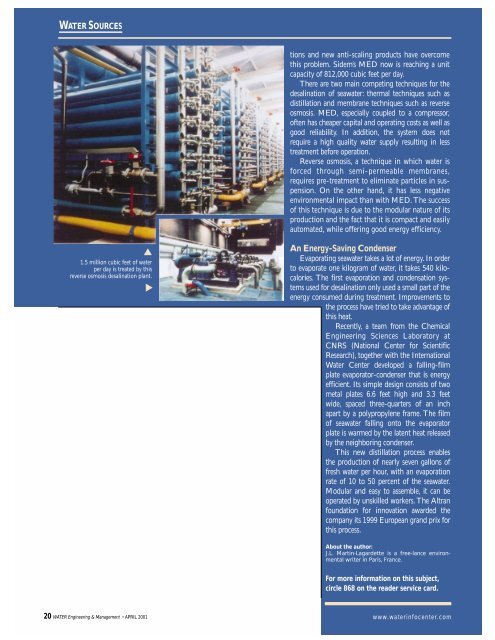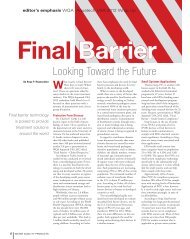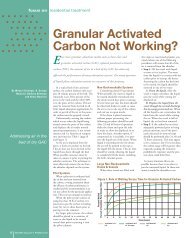Desalination of Seawater Desalination of Seawater - Water Quality ...
Desalination of Seawater Desalination of Seawater - Water Quality ...
Desalination of Seawater Desalination of Seawater - Water Quality ...
You also want an ePaper? Increase the reach of your titles
YUMPU automatically turns print PDFs into web optimized ePapers that Google loves.
WATER SOURCES<br />
tions and new anti-scaling products have overcome<br />
this problem. Sidem’s MED now is reaching a unit<br />
capacity <strong>of</strong> 812,000 cubic feet per day.<br />
There are two main competing techniques for the<br />
desalination <strong>of</strong> seawater: thermal techniques such as<br />
distillation and membrane techniques such as reverse<br />
osmosis. MED, especially coupled to a compressor,<br />
<strong>of</strong>ten has cheaper capital and operating costs as well as<br />
good reliability. In addition, the system does not<br />
require a high quality water supply resulting in less<br />
treatment before operation.<br />
Reverse osmosis, a technique in which water is<br />
forced through semi-permeable membranes,<br />
requires pre-treatment to eliminate particles in suspension.<br />
On the other hand, it has less negative<br />
environmental impact than with MED. The success<br />
<strong>of</strong> this technique is due to the modular nature <strong>of</strong> its<br />
production and the fact that it is compact and easily<br />
automated, while <strong>of</strong>fering good energy efficiency.<br />
▲<br />
1.5 million cubic feet <strong>of</strong> water<br />
per day is treated by this<br />
reverse osmosis desalination plant.<br />
▲<br />
An Energy-Saving Condenser<br />
Evaporating seawater takes a lot <strong>of</strong> energy. In order<br />
to evaporate one kilogram <strong>of</strong> water, it takes 540 kilocalories.<br />
The first evaporation and condensation systems<br />
used for desalination only used a small part <strong>of</strong> the<br />
energy consumed during treatment. Improvements to<br />
the process have tried to take advantage <strong>of</strong><br />
this heat.<br />
Recently, a team from the Chemical<br />
Engineering Sciences Laboratory at<br />
CNRS (National Center for Scientific<br />
Research), together with the International<br />
<strong>Water</strong> Center developed a falling-film<br />
plate evaporator-condenser that is energy<br />
efficient. Its simple design consists <strong>of</strong> two<br />
metal plates 6.6 feet high and 3.3 feet<br />
wide, spaced three-quarters <strong>of</strong> an inch<br />
apart by a polypropylene frame. The film<br />
<strong>of</strong> seawater falling onto the evaporator<br />
plate is warmed by the latent heat released<br />
by the neighboring condenser.<br />
This new distillation process enables<br />
the production <strong>of</strong> nearly seven gallons <strong>of</strong><br />
fresh water per hour, with an evaporation<br />
rate <strong>of</strong> 10 to 50 percent <strong>of</strong> the seawater.<br />
Modular and easy to assemble, it can be<br />
operated by unskilled workers. The Altran<br />
foundation for innovation awarded the<br />
company its 1999 European grand prix for<br />
this process.<br />
About the author:<br />
J.L. Martin-Lagardette is a free-lance environmental<br />
writer in Paris, France.<br />
For more information on this subject,<br />
circle 868 on the reader service card.<br />
20 WATER Engineering & Management • APRIL 2001<br />
www.waterinfocenter.com





